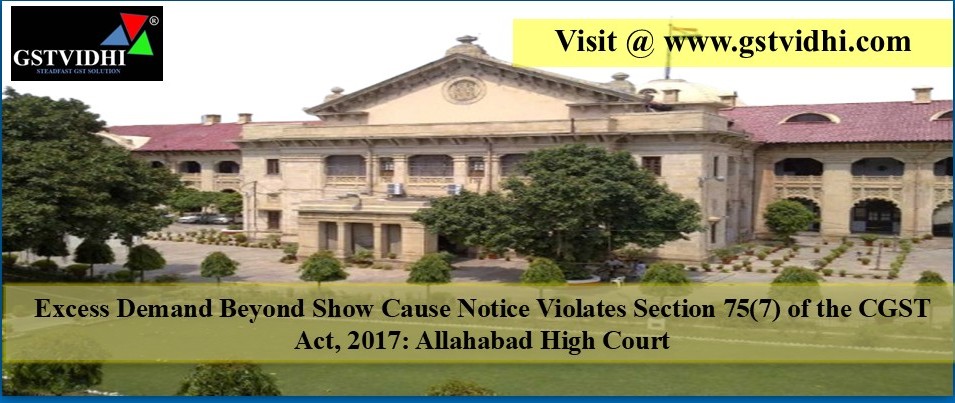
Excess Demand Beyond Show Cause Notice Violates Section 75(7) of
the CGST Act, 2017: Allahabad High Court
Introduction:
In a noteworthy decision
upholding the principles of natural justice and statutory compliance,
the Allahabad High Court quashed a GST demand order issued against M/s
Pavan Traders, holding that the final demand exceeded the amount
mentioned in the Show Cause Notice (SCN)—a clear violation of Section
75(7) of the CGST Act, 2017.
The Court emphasized that
a tax demand must remain confined to the amount and grounds specified in the
notice, and any deviation renders the order illegal and unsustainable.
Case Overview
- Case Title:
M/s Pavan Traders v. State of U.P. and Another
- Writ Tax No.:
1258 of 2025
- Court:
High Court of Judicature at Allahabad, Court No. 3
- Date of Order:
3 July 2025
Factual
Background
- The petitioner, M/s Pavan Traders,
received a Show Cause Notice (SCN) under Section 73 of the CGST Act
on 30 January 2024 in Form GST DRC-01, proposing a total
demand of ₹4,80,527.36 (inclusive of tax, interest, and penalty)
for FY 2018–19.
- Despite a reminder dated 16 April
2024 fixing a hearing for 20 April 2024, the petitioner did
not appear or respond.
- The department proceeded to issue a
final demand order on 27 April 2024, raising a total demand of ₹24,40,363.10,
including tax: ₹11,96,257.36 and penalty: ₹1,19,625.72—an
amount over five times the SCN figure.
Legal Issue
Whether the final tax
demand exceeding the amount specified in the Show Cause Notice
violates Section 75(7) of the CGST Act?
Petitioner’s
Submissions
- The impugned order demanded ₹24.40
lakhs, while the SCN had only proposed ₹4.80 lakhs.
- This discrepancy violates Section
75(7), which clearly states that:
“The amount of tax,
interest and penalty demanded in the order shall not be in excess of the amount
specified in the notice and no demand shall be confirmed on grounds other than
those specified in the notice.”
- The department acted in clear
excess of jurisdiction, and the petitioner was not given an
opportunity to defend against the higher demand.
- A prayer was made to quash the
impugned order and remand the matter back with due opportunity.
Respondent’s
Stand
- The petitioner failed to appear
despite multiple notices.
- Imposition of interest and penalty is
statutory, and absence of specific mention in
the SCN does not restrict the authority from levying them.
- Thus, the petition should be
dismissed as there is no violation of principles of natural justice.
Court’s
Observations
- Section 75(7)
was the pivotal focus of the judgment.
- The SCN quantified total liability
at ₹4,80,527.36, whereas the final order imposed ₹24,40,363.10—a
clear excess over the amount proposed.
- The final order failed to maintain
consistency with the SCN and thus violated the express statutory
provision.
- The principle of fair hearing
and certainty in taxation was defeated due to the element of
surprise in the inflated demand.
Court’s
Verdict
"On account of
violation of provisions of Section 75(7) of the Act, the order impugned cannot
be sustained."
- The writ petition was allowed.
- The impugned demand order dated 27
April 2024 was quashed and set aside.
- The matter was remanded back to
the GST authority to:
- Provide the petitioner a fair
opportunity to respond.
- Pass a fresh, reasoned order
in accordance with law.
Conclusion
The judgment in M/s
Pavan Traders is a strong reminder to the tax authorities that fair
procedure and statutory safeguards are not mere formalities—they are mandatory
constraints on administrative power. Tax adjudication must strictly follow
the "notice–reply–decision" framework to maintain the
integrity of the GST regime.
Disclaimer: All the Information is based on the notification, circular advisory and order issued by the Govt. authority and judgement delivered by the court or the authority information is strictly for educational purposes and on the basis of our best understanding of laws & not binding on anyone.
Find the Attachment (Press on Click Here )
Click here